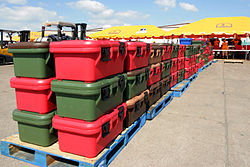Food storage
Food storage is both a traditional domestic skill and is important industrially. Food is stored by almost every human society and by many animals. Storing of food has several main purposes: Storage of harvested and processed plant and animal food products for distribution to consumers Enabling a better balanced diet throughout the year Reducing kitchen waste by preserving unused or uneaten food for later use Preserving pantry food, such as spices or dry ingredients like rice and flour, for eventual use in cooking Preparedness for catastrophes, emergencies and periods of food scarcity or famine Religious reasons (Example: LDS Church leaders instruct church members to store food)[1] Protection from animals or theft

The safe storage of food for home use should strictly adhere to guidelines set out by reliable sources, such as the United States Department of Agriculture. These guidelines have been thoroughly researched by scientists to determine the best methods for reducing the real threat of food poisoning from unsafe food storage. It is also important to maintain proper kitchen hygiene, to reduce risks of bacteria or virus growth and food poisoning. The common food poisoning illnesses include Listeriosis, Mycotoxicosis, Salmonellosis, E. coli, Staphylococcal food poisoning and Botulism. There are many other organisms that can also cause food poisoning.[2] There are also safety guidelines available for the correct methods of home canning of food. For example, there are specific boiling times that apply depending upon whether pressure canning or waterbath canning is being used in the process. These safety guidelines are intended to reduce the growth of mold and bacteria and the threat of potentially-fatal food poisoning. [edit]Food storage safety [edit]Freezers and thawing food Freezer temperature should be maintained at 0°F and below. Food should never be thawed at room temperature, this increases the risk of bacteria and virus growth and the risk of food poisoning. Once thawed, food should be used and never refrozen. Frozen food should be thawed using the following methods:[3] Microwave oven During cooking In cold water (place food in watertight, plastic bag; change water every 30 minutes) In the refrigerator Throw out foods that have been warmer than 40 °F for more than 2 hours. If there is any doubt at all about the length of time the food has been defrosted at room temperature, it should be thrown out. Freezing does not destroy microbes present in food. Freezing at 0 °F does inactivate microbes (bacteria, yeasts and molds). However, once food has been thawed, these microbes can again become active. Microbes in thawed food can multiply to levels that can lead to foodborne illness. Thawed food should be handled according to the same guidelines as perishable fresh food.[4] Food frozen at 0°F and below is preserved indefinitely. However, the quality of the food will deteriorate if it is frozen over a lengthy period. The United States Department of Agriculture, Food Safety and Inspection Service publishes a chart showing the suggested freezer storage time for common foods